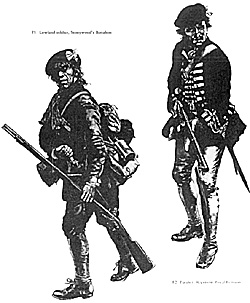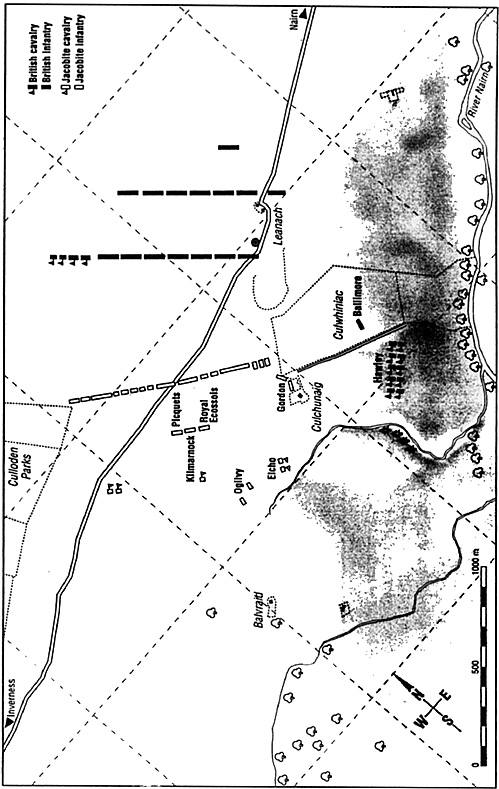 by Stuart Reid; plates by
Gerry Embleton
by Stuart Reid; plates by
Gerry Embleton
Published by Windrow and Green,
ISBN I85915-080-2, 128 pages, £
35.00 (deluxe edition ISBN 1-85915-041-1, numbered, signed, slip-eased, £
65.00)
In the military book market these days, most periods produce a reasonably steady flow of new books. Only occasionally does a book come along that stands out head and shoulders above that mainstream and which is something really special. Like Hungry Wolves is one of these special books.
The author, Stuart Reid, will be well known to many readers for his excellent 18th Century Highlanders and Wellington's Highlanders, both published by Osprey in their Men at Arms series. Others will know him for his re-enactment work. I first saw Stuart at the 18th Century Weekend organised at the Tower of London in 1993 by Dave Ryan and Partizan Press. One could not help but be captivated by Stuart's excellent presentation and by the depth of research and knowledge that he demonstrated as he described the nature of the Jacobite forces of the '45. Now these thoughts and work are set out to be shared with us all in a lovely book which is sure to become a modern classic of the period.
Like Hungry Wolves is about 9.5 by a little over 12.5 inches with 128 pages on high quality gloss paper. There are 8 pages of full colour plates and the book is filled throughout with black and white illustrations, line drawings and maps. It follows on from the other titles in the series, The Thin Red Line, Into the Valley of Death and Zulu by Windrow and Greene Ltd.
The book begins by introducing the background and outline history, The author covers from Prestonpans through the war to the preliminaries of Culloden. This is followed by two excellent chapters, one on "The British Army of 1745" and the other entitled "The Jacobite Army".
These provide a really good insight into the two armies, their structure and numbers, state of training , weapons and uniforms. these give the would be wargamer or historian a detailed picture of the opposing forces and their strengths and weaknesses. to take just one example of the wealth of information in this section, it is worth noting that each of the three elements of Jacobite cavalry , Lord Strathallan's Perthshire squadron, the Prince's Lifeguards and Bagot's Hussars are each dealt with separately giving details of their origins, numbers, standard of training and uniforms.
Elsewhere, the description of the Jacobite way of fighting is very clear and provides a very good insight into their tactics and capabilities. I is ftom this depth of knowledge and understanding that the author later goes on to explain the battle. The same level of detail is to be found in his treatment of each element of the British army. The description of the nature of the "Vestry Men", so called because the money paid when "such able bodied, idle and disorderly persons" were impressed by the local magistrate into army service went into the parish vestry, provided a quick and relatively cheap means of recruiting. The product was of dubious quality however and it is no coincidence that the author moves on to talk about discipline and punishment in the army of the time. This is but one of the many interesting aspects of this detailed study into the army of the period.
Having set the scene with the background and the armies we are then provided with a detailed chronology of the days and events leading up to the battle. The battle is dealt with in great detail unfolding through no less than eighteen very clear and well detailed maps. He has not been bound by popular misconceptions and, while not setting out to debunk other historians as seems so popular these days, he has put together a view of this, the last conventional battle on the British mainland, which is both credible and extremely well researched.
Finally, in the chapter entitled "Afterwards" the whole issue of what happened to the Jacobite wounded, the remains of the Jacobite army and the stories of atrocities are dealt with using a variety of sources to shed some new light on the popular notions and romantic histories.
Turning to the illustrations, the artwork of Gerry Embleton is nothing short of superb. There arc 8 full page colour plates, with 2 figures on each, giving 16 figures of the style and detail with which Gerry Embleton's name has become synonymous. They are accompanied by notes on each plate giving further details and sources. Added to these illustrations are the many black and white drawings and pictures which have gathered to cover virtually every page of the book adding to the wealth of written information.
Many of these, provided by kind permission of museums and collectors, provide the enthusiast with scarce contemporary material in a published from under one cover. Other illustrations include photographs taken of the modem field which help to clarify the nature of the ground and the battle.
I can honestly say that this is an excellent new book which I thoroughly recommend to all those with any interest in this period. At £ 35 it may not seem cheap but if you are looking for a real insight into the period then this book is surely for you. It combines the very best of scholarly but readable work , attractive presentation and wide ranging detail in a first class publication.

Back to 18th C. Military Notes & Queries No. 11 Table of Contents
Back to 18th Century Military Notes & Queries List of Issues
Back to Master Magazine List
© Copyright 2000 by Partizan Press
This article appears in MagWeb (Magazine Web) on the Internet World Wide Web.
Other military history articles and gaming articles are available at http://www.magweb.com